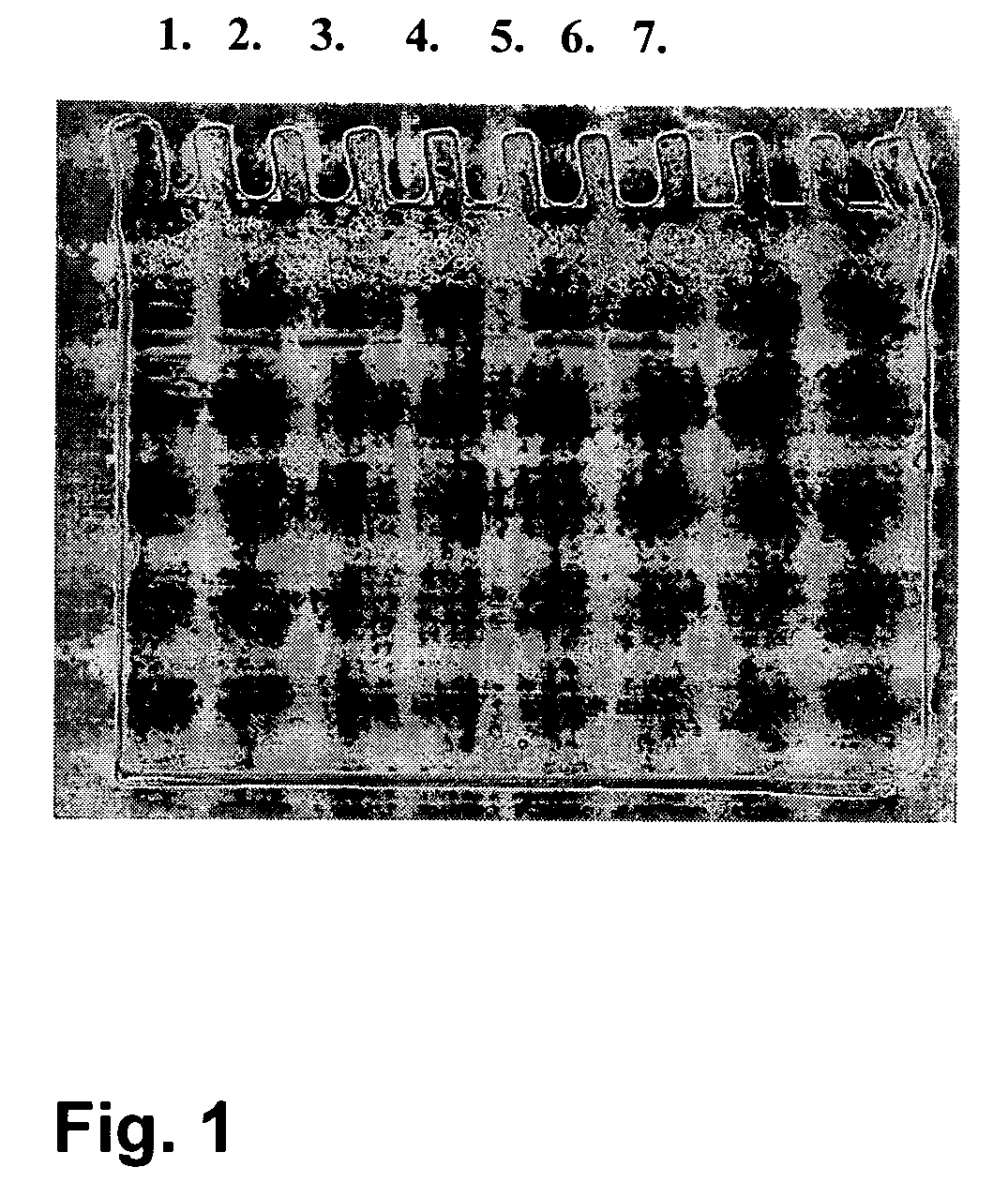Novel laccase enzyme and use thereof
a technology of laccase enzyme and laccase, which is applied in the field of new laccase enzyme, can solve the problems of reducing the strength of fabric, burdening the laundering apparatus, and easy damage to fabric, so as to reduce or avoid the use of chemical bleaching agents in denim treatment, the effect of reducing the amoun
- Summary
- Abstract
- Description
- Claims
- Application Information
AI Technical Summary
Benefits of technology
Problems solved by technology
Method used
Image
Examples
example 1
Production and Purification of the Thielavia Laccase
Production of the Thielavia Laccase
[0151] Various strains from the culture collection of Roal Oy were screened for their ability to produce laccases with indicators Remazol Brilliant Blue R-478, tannic acid, and guaiacol as described in Kiiskinen et al. (2004). Thielavia arenaria ALKO4197 showed positive reactions on guaiacol and Remazol Brilliant Blue R-478.
[0152]Thielavia fungus was maintained on PD agar (Difco) at +4° C. The inoculation and production medium contained: 25 g / l glucose (AnalaR), 27.5 g / l Bacto yeast extract (Difco), 0.5 mg / ml Indulin AT (Sigma), 0.04 l / l mineral solution (1.0 g / l CaCl2.2H2O (Riedel-de Haën), 1.0 g / l FeSO4.7H2O (Riedel-de Haën), 0.1 g / l ZnSO4.7H2O (Merck), 0.16 g / l CuSO4.5H2O (Merck), 1.0 g / l Na2EDTA (Riedel-de Haën)). Glucose was sterilized separately and combined aseptically to the medium.
[0153] The microbe was cultivated in 50 or 200 ml volume on a rotary shaker (200 rpm) at temperature of ...
example 2
Characterization of the Purified Thielavia arenaria Laccase, wt TaLcc1
Molecular Weight and pI
[0157] Molecular weight of the Thielavia arenaria laccase (wt TaLcc1) was determined on SDS-PAGE according to Laemmli (1970). The gels used in the SDS-PAGE analysis were ready-made 12% Tris HCl gels (BioRad). Protein bands were visualized by staining with Coomassie Brilliant Blue (R 350; Pharmacia) and compared with molecular weight markers (Prestained Protein Marker Broad Range #7708S; New England BioLabs, Beverly, Mass.). The molecular weight of the Thielavia areanaria laccase was approximately 80 kDa. The isoelectric point of the laccase was determined with isoelectric focusing within the pH range of 3-9 (Pharmalyte IEF, Pharmacia) on a LKB 2117 Multiphor II Electrophoresis System (LKB Pharmacia, Bromma, Sweden) according to the manufacturer's instructions. Bands containing laccase activity were visualized by staining the gel with 2 mM ABTS in 25 mM succinate buffer (pH 4.5) and protei...
example 3
Cloning of the Thielavia arenaria ALKO4197 Gene Encoding TaLcc1
[0163] Standard molecular biology methods were used in the isolation and enzyme treatments of DNA (plasmids, DNA fragments), in E. coli transformations, etc. The basic methods used are described in the standard molecular biology handbooks, e.g. Sambrook et al. (1989) and Sambrook and Russell (2001).
[0164] The genomic library of Thielavia arenaria ALKO4197 was made to Lambda DASH®II vector (Stratagene, USA) according to the instructions from the supplier. The chromosomal DNA, isolated by the method of Raeder and Broda (1985), was partially digested with Sau3A. The digested DNA was size-fractionated in an agarose gel after which the fragments of the chosen size (9-23 kb) were isolated, dephosphorylated and ligated to the BamHI digested lambda vector arms. The ligation mixture was packaged using the Gigapack III XL packaging extracts according to the manufacturer's instructions (Stratagene, USA). The titer of the genomic ...
PUM
| Property | Measurement | Unit |
|---|---|---|
| Temperature | aaaaa | aaaaa |
| Temperature | aaaaa | aaaaa |
| Temperature | aaaaa | aaaaa |
Abstract
Description
Claims
Application Information
 Login to View More
Login to View More - R&D
- Intellectual Property
- Life Sciences
- Materials
- Tech Scout
- Unparalleled Data Quality
- Higher Quality Content
- 60% Fewer Hallucinations
Browse by: Latest US Patents, China's latest patents, Technical Efficacy Thesaurus, Application Domain, Technology Topic, Popular Technical Reports.
© 2025 PatSnap. All rights reserved.Legal|Privacy policy|Modern Slavery Act Transparency Statement|Sitemap|About US| Contact US: help@patsnap.com



